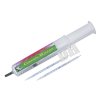RastaMonsta
Active Member
so how do outdoor growers do it with temps at 130 and only 400 ppm? im confused.
Not much grown at 130 that I know about. All strains i know die indoors at temps way below thatso how do outdoor growers do it with temps at 130 and only 400 ppm? im confused.
Yeah that^!!If you wait a couple of days I'm going to write up complete instructions.




i love your avatar.... isnt that one of the Fabulous Furry Freak Bros?i wanna watch.
Without the trap you can't tell if the mix is fermenting except for very little bubbles on surface of water. Also, the mix smells like baking bread and you may not want that smell in your grow room. But the air trap is not mandatory to make this work.so what if i do this without the air trap and just leave the container open? similar results? i just dont understand why we want the little air bubble every few seconds ....
Co2 is not very poisonous unlike carbon monoxide. You can take several times the amount of co2 that you're producing before it's a problem.ok one more question...assuming i have this dialed in and im adding 1500 ppm, what precautions should i take for my own health? i already see a difference in my plants growth and im spending alot of time in there.
Seems like I read that over 5000 ppm is dangerous to humans?Co2 is not very poisonous unlike carbon monoxide. You can take several times the amount of co2 that you're producing before it's a problem.
Seems like I read that over 5000 ppm is dangerous to humans?
Thanks for the detail and quote. So 5% = 5000 ppm is a problem but if you overshoot 1500 ppm and end up in the two thousands it's not going to hurt you much.Basic Information about Concentrations of CO2 in Air
this tells me not to worry pretty much ...
- <LI class=LI_Spaced>1,000,000 ppm of a gas = 100 % concentration of the gas, and 10,000 ppm of a gas in air = a 1% concentration. <LI class=LI_Spaced>At 1% concentration of carbon dioxide CO2 (10,000 parts per million or ppm) and under continuous exposure at that level, such as in an auditorium filled with occupants and poor fresh air ventilation, some occupants are likely to feel drowsy. <LI class=LI_Spaced>The concentration of carbon dioxide must be over about 2% (20,000 ppm) before most people are aware of its presence unless the odor of an associated material (auto exhaust or fermenting yeast, for instance) is present at lower concentrations. <LI class=LI_Spaced>Above 2%, carbon dioxide may cause a feeling of heaviness in the chest and/or more frequent and deeper respirations. <LI class=LI_Spaced>If exposure continues at that level for several hours, minimal "acidosis" (an acid condition of the blood) may occur but more frequently is absent. <LI class=LI_Spaced>Breathing rate doubles at 3% CO2 and is four times the normal rate at 5% CO2.
- Toxic levels of carbon dioxide: at levels above 5%, concentration CO2 is directly toxic. [At lower levels we may be seeing effects of a reduction in the relative amount of oxygen rather than direct toxicity of CO2.]
maybe just grow a third arm or something ...Thanks for the detail and quote. So 5% = 5000 ppm is a problem but if you overshoot 1500 ppm and end up in the two thousands it's not going to hurt you much.
